Telescope
The 0.43 m telescope in Spain is the first telescope in the Alnitak network.
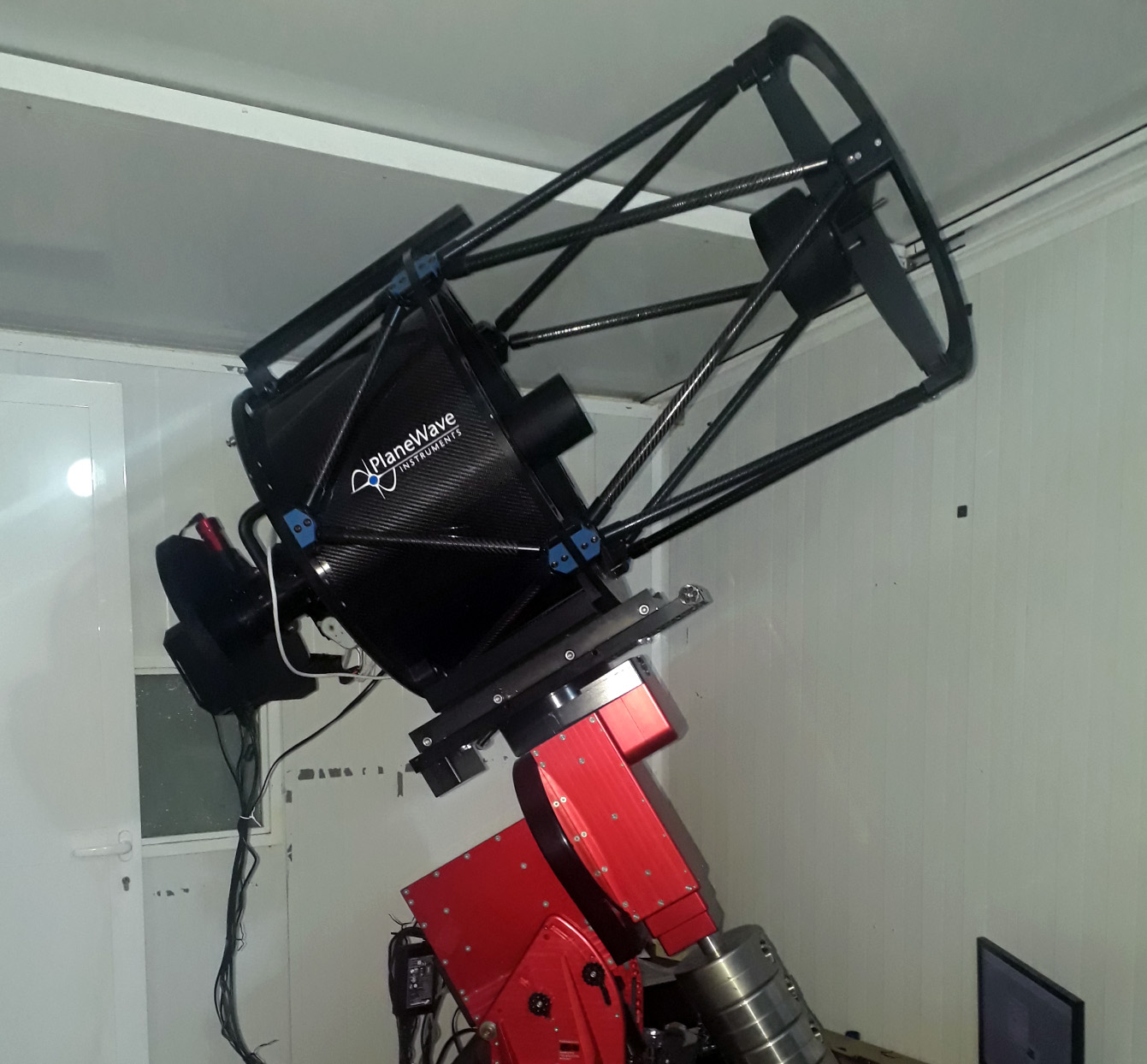
A1
The 0.43 m A1 telescope is a dual-mission hybrid imaging and science platform, based on the Corrected Dall-Kirkham (CDK) optical design with 2939 mm focal length. The optical tube assembly is made by Planewave Instruments based in Adrian, MI, USA. The telescope design is coma free, has no off-axis astigmatism, and has a flat field offering pin-point stars across the whole field of view. It consists of three components: an ellipsoidal primary mirror, a spherical secondary mirror and a corrector lens group.
The telescope is based on the Software Bisque Paramount ME German Equatorial Mount that can track deep sky objects at the sidereal rate, as well as solar system bodies (minor planets and comets) in the orbital tracking mode. See Creating Custom Plans page for additional information.
Sample of images acquired with the A1:
LRGB: IC 342, NGC 206, Messier 101, Messier 86
Narrowband: NGC 6960 the Veil, Sh2-86, Sh2-155 the Cave Nebula (Gascoyne 2024), The Core of the Heart Nebula (Gascoyne 2024)
The mirrors are made of fused silica with low coefficient of thermal expansion.
The carbon fiber truss optical tube assembly provides fast cooling times and minimizes thermal expansion and focus shift due to the ambient temperature changes.
The telescope is equipped with three fans on the backplate to pull air through the telescope’s primary mirror.
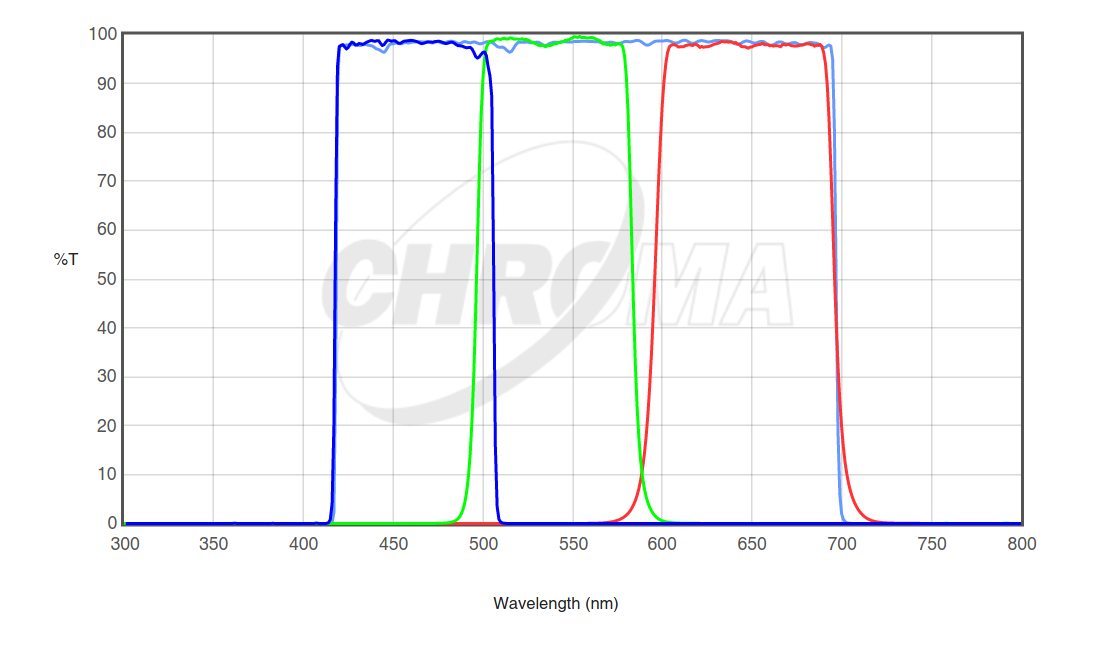
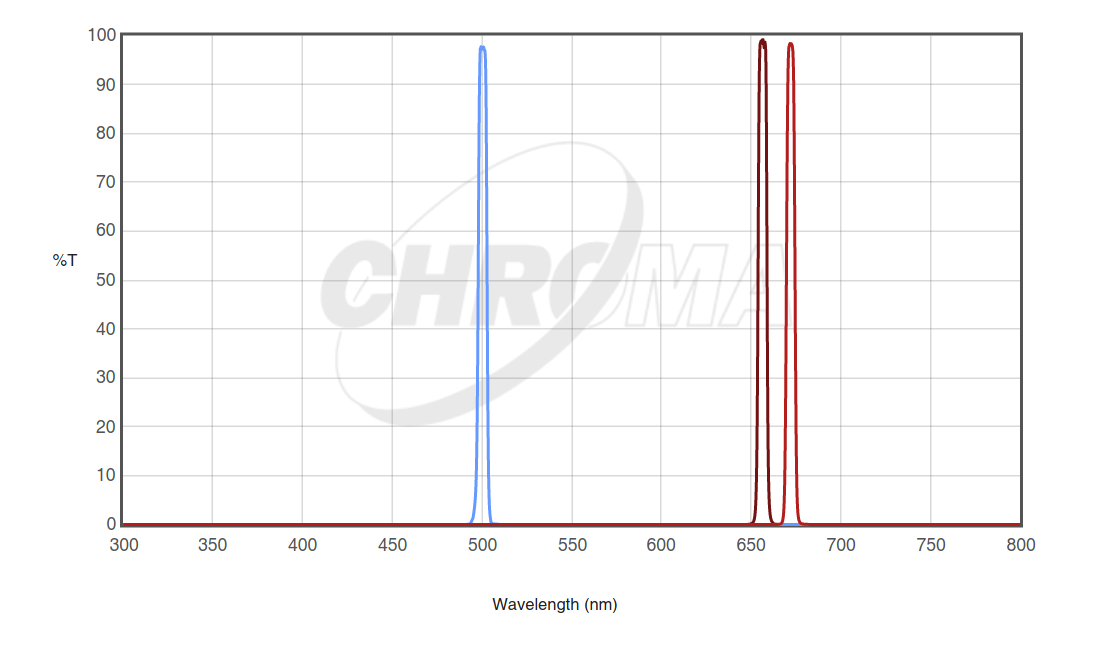
Active backplate cooling allows to the telescope to reach thermal equilibrium quick enough to be ready for precise observations early in the evening. An additional three fans located on the side of the tube assembly blow air across the primary mirror to ensure a boundary layer of air is not distorting the wavefront. Open tube assembly reduces the required refocusing intervals to a minimum during the imaging sessions, which provides an observer with efficient observing time.
The telescope provides the full set of Johnson/Bessel photometric UBVRI filters made by Andover Corporation in Salem, NH, USA. The filters are made of Schott glass substrates (ground and polished) laminated with index-matching epoxy and are 5 mm ± 0.1 mm thick. This makes them parfocal, which eliminates refocusing requirement on filter change. The filters are fully coated to MIL-C-48497A standard, with peak transmission specified as following:
| Johnson/Bessel Filter Specifications | Ultraviolet | Blue | Visible | Red | Infrared |
|---|---|---|---|---|---|
| Nominal CW/L | 365 nm | 440 nm | 520 nm | 630 nm | 900 nm |
| Nominal FWHM | 60 nm | 100 nm | 90 nm | 120 nm | 300 nm |
| Nominal Transmission | > 50% | > 55% | > 70% | > 70% | > 70% |
The photometric filters offer 1/4-wave propagated wavefront or better, < 0.5 arcminute substrate parallelism.
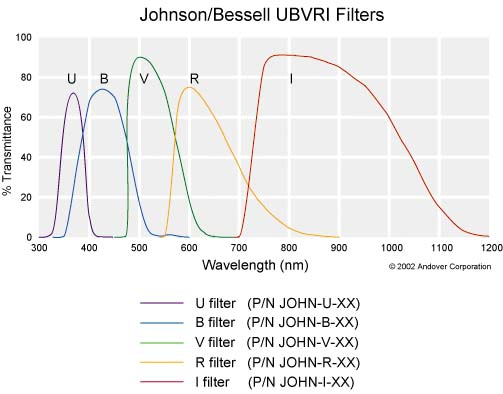
For imaging purposes, A1 offers the standard color filter set: NIR/UV-blocked Luminance, Red, Green and Blue made by Chroma in Bellows Falls, VT, USA. These filters offer excellent color separation and image rendition and are optimized to reduce star halos and reflections. There is a spectral gap between the green and red filters that allows to reduce the effects of light pollution. The green and the blue filters overlap at the [O III] emission line at 500.7 nm offering correct teal color rendition for the oxygen signal in planetary nebulae.
For narrowband imaging, A1 features Chroma filters with 5 nm bandwidth for H-alpha, [O III] and S II lines with > 97% transmittance. These filters are parfocal with broadband LRGB filter set.
Transformation Coefficients
The photometric transformation coefficients for our A1 telescope were kindly provided by Michael Freeberg.
| Telescope: | 0.43 m f/6.8 Corrected Dall-Kirkham (A1) |
| Observatory Coordinates: | 38.165641, 357.6733, Elevation: 1650 m 38°9’56″N 2°19’36″W |
| MPC Code: | I79 |
| Camera: | Moravian Instruments C3-61000 Pro, Back-Illuminated CMOS |
| Quantum Efficiency: | > 87% peak |
| Field of View: | 0.7° × 0.47° |
| Sensor Orientation Angle: | 268.7° |
| Image Resolution and Scale: | 4788 × 3194 in 2 × 2 binning mode, 0.53”/px |
| Full Well: | 52,800 e- |
| Filters: | Chroma LRGB, Chroma 5 nm Narrowband H-alpha, O III and S II, Andover Photometric Johnson/Bessel UVBRI |
| Timezone: | UTC +1:00 Madrid, Daylight Savings Time is Observed |
| Minimum Target Elevation: | ~ 40° |
| Calibration Frames (Exposure): | 30, 60, 180, 300 s |
| Optical Design | Corrected Dall-Kirkham |
| Aperture | 17 inch (432 mm) |
| Focal Length | 2939 mm (115.71 inch) |
| Focal ratio | F/6.8 |
| Central Obstruction | 23.7% by surface area; 48.6% of the primary mirror diameter |
| Optical Performance | 6.5 micron rms at 21mm and 9.6 micron at 26mm off-axis |
| Upper Cage | Carbon fiber truss |
| Lower Cage | Carbon fiber truss with carbon fiber light shroud |
| Optimal Field of View | 70mm image circle |
| Diameter | 190 mm (7.48 inch) |
| Material | Fused silica (quartz) |
| Shape | Spherical |
| Coating | Enhanced aluminum – 96% |
| Optical Diameter | 17 inch (432 mm) |
| Outer Diameter | 17.5 inch (445 mm) |
| Shape | Prolate ellipsoid |
| Material | Fused silica (quartz) |
| Coating | Enhanced aluminum – 96% |
| Optical | 105 mm (4.13 inch) |
| Number of lenses | 2 |
| Coating | Broadband AR Coatings (less than .5% reflected from 400 to 700nm) |
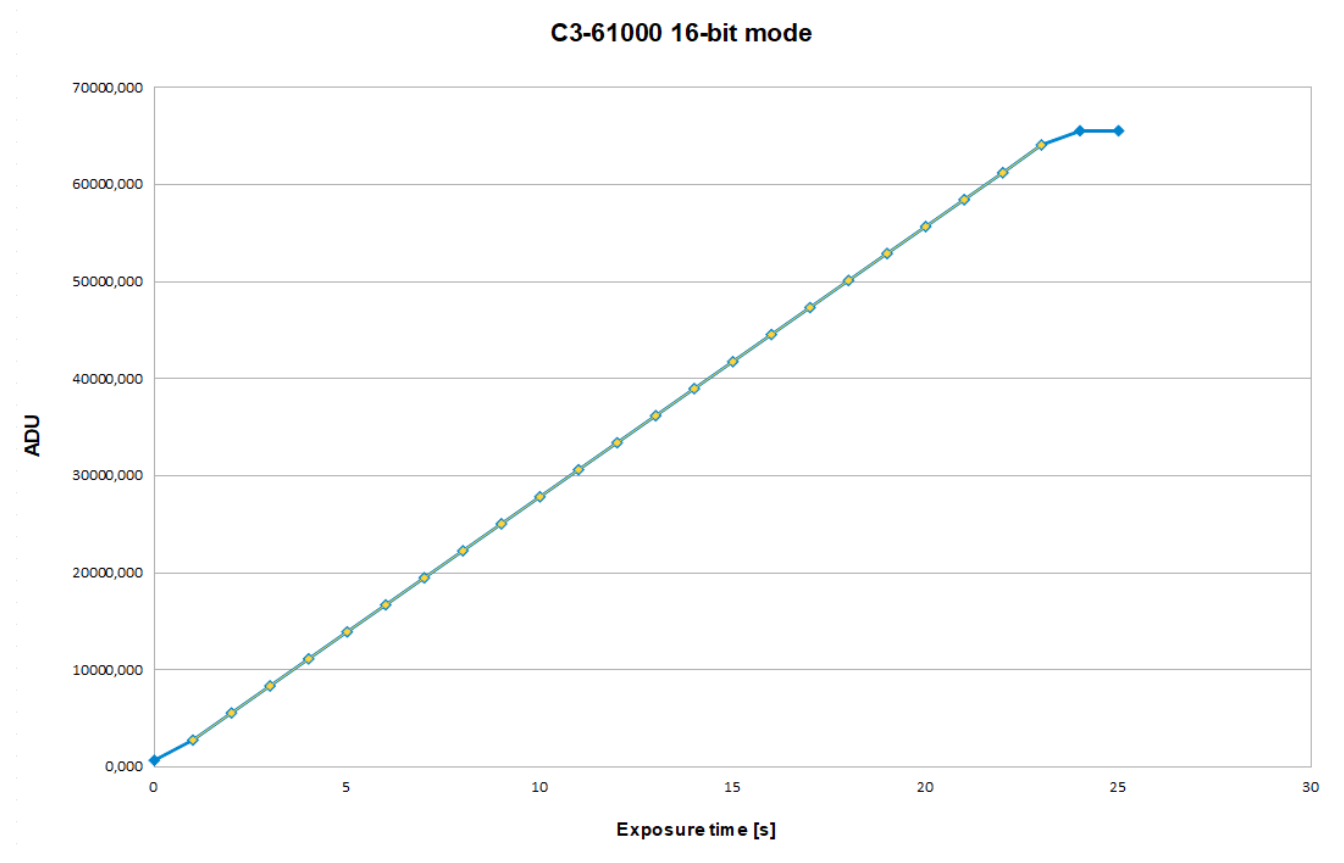
As the primary imaging instrument the telescope features Moravian Instruments C3-61000 Pro camera made in Zlin, Czech Republic. It is based on the latest generation of CMOS sensors – the back-illuminated Sony IMX455. The camera features a full-frame industrial-grade 24 × 36 mm sensor with 3.76 μm square pixels. Its native resolution is 9576 × 6388, providing 0.265”/px imaging scale. By default the telescope operates in the 2 × 2 binning mode with 0.53”/px scale that is suitable for typical 1-2” FWHM seeing conditions available at the site. The field of view of the telescope is 0.7° × 0.47°.
The camera installed offers very low dark current and full well capacity exceeding 50 ke- with full 16-bit digitization. The light response of the camera is nearly linear all the way to the stated full well capacity which makes the system ideally suitable for scientific research missions.
| Gain number | Gain in dB | Gain factor | Conversion factor e-/ADU | Read noise RMS, e- | Full well capacity, e |
|---|---|---|---|---|---|
| 0 | 0.0 | 1× | 0.80 | 3.51 | 52,800 |
| 2749 | 9.7 | 3× | 0.80 | 3.51 | 17,100 |
| 2750 | 9.7 | 3× | 0.26 | 1.46 | 16,900 |
| 4030 | 36.0 | 63× | 0.18 | 1.39 | 11,600 |
By default, the telescope operates at 0 dB gain revealing the maximum full well capacity achievable with this sensor. For a full-frame read the shortest exposure time possible is 126 ms. The camera in A1 is capable of cooling 40 °C below ambient temperature and the sensor temperature is regulated with ± 0.1 °C precision.
Calibration Frames
Alnitak Remote Observatories provides the full set of bias, dark and flat calibration frames for 30, 60, 180 and 300 s exposures in each filter. These frames are updated periodically to ensure high-precision calibration is possible at any time. (Note: Johnson U flat field calibration is not available at the moment, as the currently used calibration lamp is not emitting at very short wavelengths.)
The suitability of the Sony IMX455 CMOS sensor for precise photometry has been studied by Alarcon et al. (2023).
